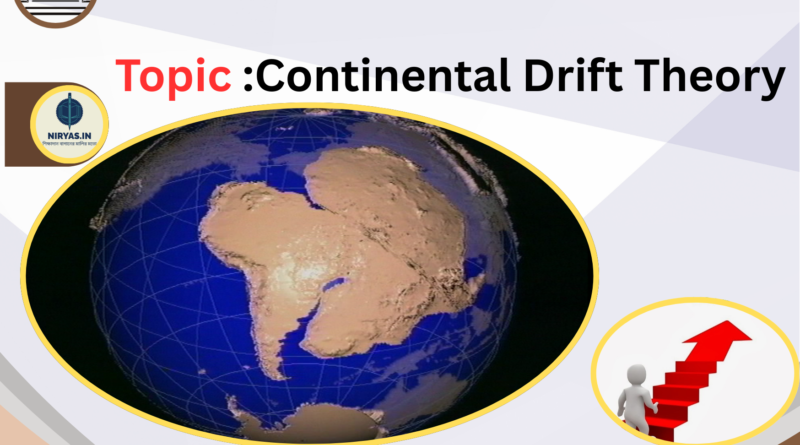Continental Drift Theory
Continental Drift Theory
The gateway to teaching or doing research at a higher level is to pass NET/SET. To make this task a little easier for the students, we have started discussing NET/SET Geography on the subject of geography. Earlier in the NET/SET SYLLABUS For Geography post, we mentioned the complete syllabus and the individual topics that have emerged by breaking the syllabus. Now it is time to discuss each topic in detail. As the first topic, we will now discuss Continental Drift Theory.
⟽ Previous Part : NET/SET Geo Topic Plan
✦ Introduction : Continental Drift Theory is the theory that the Earth’s continents have moved over time and are still moving today. This movement has resulted in the continents changing their positions relative to each other and the ocean floor. The continents have changed their positions over millions of years, resulting in the modern configuration of the continents. The continents are still moving relative to each other and the ocean floor, although at a very slow rate (about 2-3 cm/year). The movement of the continents has resulted in the creation of new oceans, the formation of mountain ranges, and the separation of previously joined landmasses. The continents have moved relative to each other, resulting in the creation of new oceans and the formation of mountain ranges, and relative to the ocean floor, resulting in the creation of new oceanic crust and the separation of previously joined landmasses.
✧ Main key points :
i. According to Wegener, The continents were once joined together in a single supercontinent called Pangaea, which existed from approximately 300 to 200 million years ago (Ma) (Wegener, 1929).
ii. According to De Mets et al., Over millions of years, the continents have drifted apart and changed their positions, with the average rate of movement being about 2-3 cm/year (De Mets et al., 1990).
iii. According to Molnar & Tapponnier, The movement of the continents is still ongoing today, resulting in the creation of new oceans and the formation of mountain ranges, such as the Himalayas, which are still rising by about 1 inch (2.5 cm) per year (India-Eurasia collision) (Molnar & Tapponnier, 1975).
✧ Definition of Continental Drift Theory :
Continental Drift refers to the movement of the Earth’s continents relative to each other and the ocean floor. This movement has resulted in the continents changing their positions over time, sometimes colliding and merging, and other times drifting apart.
Here are the top 10 definitions of Continental Drift by famous geographers: Continental Drift Theory
1. Alfred Wegener (1880-1930) : “The continents have moved over the surface of the Earth, and are still moving, relative to each other and the ocean floor.” (Wegener, 1929)
2. Arthur Holmes (1890-1965) : “Continental drift is the movement of the continents relative to each other and the ocean floor, resulting in the creation of new oceans and the formation of mountain ranges.” (Holmes, 1944)
3. Marie Tharp (1920-2006) : “Continental drift is the movement of the continents relative to each other and the ocean floor, resulting in the creation of new oceans and the formation of mountain ranges, as evidenced by the mid-ocean ridges.” (Tharp, 1959)
4. Bruce Heezen (1924-1977) : “Continental drift is the movement of the continents relative to each other and the ocean floor, resulting in the creation of new oceans and the formation of mountain ranges, as evidenced by the mid-ocean ridges and the magnetic stripes.” (Heezen, 1960)
5. Harry Hess (1906-1969) : “The continents have moved over the surface of the Earth, driven by convection currents in the mantle, resulting in the creation of new oceans and the formation of mountain ranges.” (Hess, 1962) Continental Drift Theory
6. Fred Vine (1939-present) : “Continental drift is the movement of the continents relative to each other and the ocean floor, resulting in the creation of new oceans and the formation of mountain ranges, as evidenced by the magnetic stripes and the plate tectonics.” (Vine, 1966)
7. Lynn Sykes (1937-present) : “Continental drift is the movement of the continents relative to each other and the ocean floor, resulting in the creation of new oceans and the formation of mountain ranges, as evidenced by the seismic data and the plate tectonics.” (Sykes, 1967) Continental Drift Theory
8. Dan McKenzie (1942-present) : “Continental drift is the movement of the continents relative to each other and the ocean floor, resulting in the creation of new oceans and the formation of mountain ranges, as evidenced by the plate tectonics and the mantle convection.” (McKenzie, 1967)
9. Drummond Matthews (1931-1997) : “Continental drift is the movement of the continents relative to each other and the ocean floor, resulting in the creation of new oceans and the formation of mountain ranges, as evidenced by the magnetic stripes and the plate tectonics.” (Matthews, 1967)
10. Jason Morgan (1935-present) : “Continental drift is the movement of the continents relative to each other and the ocean floor, resulting in the creation of new oceans and the formation of mountain ranges, as evidenced by the plate tectonics and the hotspots.” (Morgan, 1968)
✧ Brief overview of the Continental Drift Theory : The theory of Continental Drift was first proposed by Alfred Wegener, a German meteorologist and geophysicist, in 1912. Wegener observed that the continents seemed to fit together like a jigsaw puzzle and proposed that they had once been joined together in a single supercontinent, which he called Pangaea (Wegener, 1929).
First proposed by Alfred Wegener : Alfred Wegener, a German meteorologist and geophysicist, first proposed the theory of Continental Drift in 1912, while working at the University of Marburg in Germany.
Observed that the continents seemed to fit together like a jigsaw puzzle : Wegener noticed that the continents had similar shapes and coastlines, suggesting that they had once been joined together. For example, the eastern coast of South America and the western coast of Africa seemed to fit together perfectly, with similar rock formations and fossils.
Proposed that they had once been joined together in a single supercontinent : Wegener proposed that the continents had once been part of a single supercontinent, which he called Pangaea. Pangaea is thought to have existed from approximately 300 to 200 million years ago, during the Paleozoic and Mesozoic eras.
Pangaea : Pangaea was a single supercontinent that existed on Earth before the continents drifted apart. It is thought to have been surrounded by a single global ocean, known as the Panthalassic Ocean.
✪ Key Points :
Wegener’s observation : Wegener’s observation that the continents seemed to fit together like a jigsaw puzzle was a key insight that led to the development of the theory of Continental Drift.
Pangaea : The concept of Pangaea, a single supercontinent that existed on Earth before the continents drifted apart, is a central idea in the theory of Continental Drift.
Continental movement : The theory of Continental Drift proposes that the continents have moved over time, resulting in the creation of new oceans and the formation of mountain ranges.
✪ Data :
Age of Pangaea : Pangaea is thought to have existed from approximately 300 to 200 million years ago, during the Paleozoic and Mesozoic eras (Wegener, 1929).
Size of Pangaea : Pangaea is estimated to have been approximately 140 million square kilometers in size, which is roughly the size of the modern-day continents of Africa, Asia, and Europe combined (Wegener, 1929).
Rate of continental movement : The rate of continental movement is estimated to be approximately 2-3 cm/year, which is roughly the rate at which fingernails grow (De Mets et al., 1990).
✧ Timeline of the theory of Continental Drift :
✪ Pre-Wegener (Before 1912) :
1596: Flemish cartographer Abraham Ortelius observes that the continents seem to fit together like a jigsaw puzzle.
18th and 19th centuries: Various scientists propose that the continents have moved over time, but their ideas are not widely accepted.
✪ Wegener’s Theory (1912-1930) :
1912: Alfred Wegener proposes the theory of Continental Drift in a lecture at the German Geological Society.
1915: Wegener publishes his book “The Origin of Continents and Oceans,” which outlines his theory of Continental Drift.
1920s: Wegener’s theory is met with skepticism by many scientists, but it gains popularity among some geologists.
✪ Development of Plate Tectonics (1950s-1960s) :
1950s: The discovery of mid-ocean ridges and the observation of seafloor spreading provide evidence for Continental Drift.
1960s: The theory of plate tectonics is developed, which explains the movement of the continents and the creation of new oceanic crust.
✪ Modern Understanding (1970s-Present) :
1970s: The theory of plate tectonics becomes widely accepted, and Continental Drift is recognized as a key component of this theory.
1980s: The use of GPS and other technologies allows scientists to measure the movement of the continents with greater precision. ☑ Join our Course : SET Geo
Present day: Continental Drift is recognized as a fundamental concept in geology, and it continues to be studied and refined by scientists around the world.

